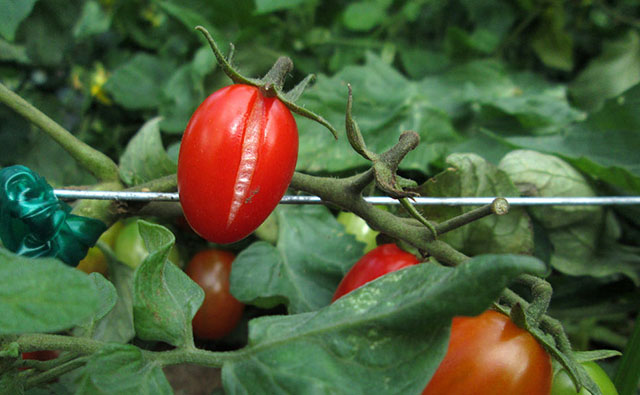Industry News, Feature Article, Company News, Agriculture & Feed, PR, Adjuvants
Discussion of The Application of Gibberellic acid with Surfactant Adjuvants for Fruit Cracking Prevention

Industry News, Feature Article, Company News, Agriculture & Feed, PR, Adjuvants

Image: Scot Nelson, Flickr
Gibberellic acids (GAs) are the class of tetracyclic diterpenoid substances, which are used as growth regulator treatment. The function of GAs not only to promote the plant growth, also to induce phase transitions during development.
GAs can regulate the seed dormancy. Some plant seeds are under the dormancy condition when they were purchasing. GA treatment would stimulate seed germination and induces of the hydrolytic enzymes such as α-amylase and protease. The seeds treated by GA were led to germinate under the dark environment and low temperature. According to the plant physiology, GAs regulate the plant development, especially for the dwarf cultivars. When the light compensation point of plants is reduced, GA increases the light saturation point range, that improves the effects of light intensity on the plant growth and leaf development.
GA also influences the control of flowering time and sex expression. For example, sprays the growth regulator @500~1500ppm on female cucumber plant to induce the male flower development. Sprays the treatment @10~100 ppm on violet or geranium for substitute GA for long-day under the short-day condition.
Fruit cracking was caused by plant physiological imbalance – the growth of peel was not adapted to the growth of the fleshy tissue. Some research results that the factors influence fruit cracking, the factors include a) the turgor pressure; b) the elasticity of fruit skin; c) the structure of fruit skin; d) the growth rate.
The turgor pressure is influenced by the contents of water, GAs and abscisic acid. The elasticity level is influenced by the contents of Ca and cell wall. The relaxed DNA of cell determines the structure of fruit skin. When the factors under the imbalance condition, the fruits will be cracking.
On the other way, the heavy rain also causes fruit cracking because the water uptake increases the turgor pressure level. The growth rate of fleshy tissues (fresh) is faster than fruit peel due to the drought damage during the dry season. But when the rain is coming, plants absorb water and nutrition quickly. The development of sarcocarp (fresh) is imbalance in the peel that turgor pressure level is increasing and causes fruit cracking. Growers often spraying GA to balance the turgor pressure system.
Plant waxy blade surface is covered the vitro cutin membrane. The cutin membrane can lock water content in the tissue to anti transpiration and regulates the water balance that protects chloroplast functions and maintains ion homeostasis. In general, the growers spray regulation treatment agents and mix with surfactant adjuvants to improve the effects. PINEYE® Emulsion has wetting and extending properties, it is the excellent choice of adjuvant to decrease shear angle and increase extension area to improve agrochemical efficacy.
But the researches result that the surfactants may not improve the effects for the GA and will increase the cost. GA also shows good efficacy when spraying it independently. So, we advise growers spray adjuvants in a combination way according to the different plant growth stages.
PINEYE® Emulsion is the nonionic sticker type adjuvant. The liquid sprayed on the surface of foliage and fruits will be forming the sticky coating. The natural coating can assistant fruit peel regulate turgor pressure level with fleshy tissues (fresh) by physical effect way, just like the sealants. It is a different method comparing with plant physiology mechanism of regulation agents.
Especially on the fruit ripening stage, spraying PINEYE® Emulsion on fruits and leaves on the rainy season, the organic sticky coating can prevent rain wash out the fungicides or regulator agents. The surfactant adjuvant effects a blocking performance to decrease the rain put pressure on the peel. The sticky residues also suture cracked peel and prevent cracking deteriorating. Using GAs regulators with PINEYE® Emulsion complement each other that can be used in combination with different situations.
| REGULATORS | Seeds | Leaves | Fruits | Stem | Roots |
| Sprout | ○ | – | – | – | ○ |
| Seeding | ○ | ○ | – | ○ | ○ |
| Vegetative | ○ | ○ | – | ○ | ○ |
| Budding | ○ | ○ | – | ○ | ○ |
| Flowering | ○ | ○ | – | ○ | ○ |
| Ripening | ○ | ○ | ○ | ○ | ○ |
| REGULATORS | Seeds | Leaves | Fruits | Stem | Roots |
| Sprout | × | – | – | – | × |
| Seeding | × | ○ | – | ○ | × |
| Vegetative | × | ○ | – | ○ | × |
| Budding | × | ○ | – | ○ | × |
| Flowering | × | ○ | – | ○ | × |
| Ripening | × | ○ | ○ | ○ | × |